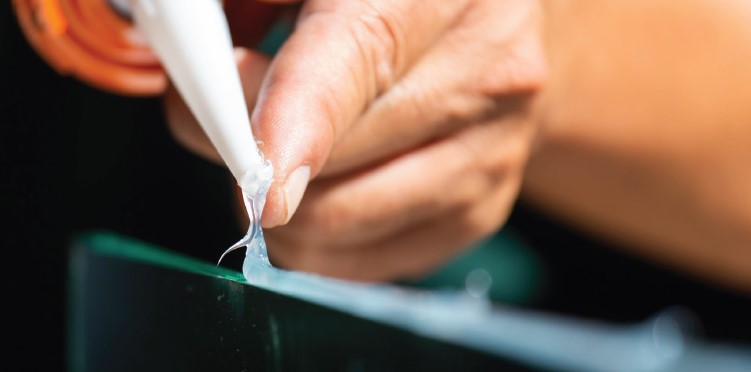Plasticizers for Adhesives and Sealants
In this issue, we examined the topic of plasticizers. As it is known, plasticizers are a popular additive in
adhesive and sealant formulas. They improve adhesive performance by adding much-needed flexibility, improving viscosity, toughness, set time functionality,
impact resistance, and even adhesion.
A plasticizer is an additive that is added to a polymer system to improve its flexibility or processability. Plasticizers often influence viscosity, decrease the glass transition temperature, and reduce a product’s elastic modulus.
Effective plasticizing compounds used in caulks and sealants include phthalates and terephthalates. Plasticizers in this category include Butyl Benzyl Phthalate (BBP), DIHP, Diisononyl Phthalate (DINP), Dioctyl Terephthalate (DOTP), and DBT. Plasticizers containing dibenzoates, such as Dipropylene Gycol Dibenzoate, are also commonly used.
Plasticizers are often chosen based on polymer compatibility and desired end product qualities. By selecting a plasticizer that is compatible with the polymer, the plasticizer is prevented from leaking out of the product, hence reducing the benefits of plasticization
is avoided.
Plasticizer persistence or resistance to migration from adhesive or sealant contributes to the lifespan of a product. Weathering, such as exposure to sunshine and severe temperatures, can have an impact on persistence, as can extraction with agents such
as soapy water.
Plasticizer loss causes the caulk or sealant to stiffen, shrink, or become brittle. Acrylic, polyvinyl acetate (PVA), and polyvinyl chloride (PVC) sealants often perform well with epoxidized oils such as phthalates, terephthalates, benzoates, and Epoxidized Soybean Oil (ESO).
Polyamides and polysulfides may benefit from the use of a phosphate ester such
as Tributyl Phosphate (TBP) or Trioctyl Phosphate (TOF), whilst polyurethanes and epoxies may benefit from the use of polymeric polyesters. The amount of plasticizer required varies depending on the formulation, but can range from 5 to 50 percent by weight of the product.
However, because the complexity of adhesive and sealant formulations grows each year, you must choose a specific plasticizer to modify the characteristics of your formulations in a certain direction in order to fulfill the criteria. Understanding the fundamentals of plasticizers used in adhesives and sealants is essential for achieving the appropriate flexibility.

Need for Plasticizers
Plasticizers are utilized in the formulation of all adhesives and sealants. They are mostly utilized for the final bond and to improve low temperature characteristics. Plasticizers, on the other hand, can give additional benefits that are valuable to both the formulator
and the end user.
Adhesives and sealants contain a wide range of resins and plasticizers. There are several chemical plasticizer broad families and types. This makes choosing a plasticizer for a specific adhesive or sealant recipe extremely challenging.
Plasticizers should be thought of in connection to:
• Compatibility with the formulation’s base pol ymer,
• The ultimate qualities that the formulator is attempting to acquire,
• The treatment that the adhesive will get during assembly and application.
Plasticizers Used in Adhesives and Sealants
Plasticizers, like diluents, are non-volatile solvents for the base resin that are added into the formulation, separating the polymer chains and making deformation simpler. Plasticizers can thereby enhance both the handling and final qualities of the adhesive.
Plasticizers are also one of the least expensive additives used in adhesives and sealants, and depending on the application and formulation, can be employed in rather high quantities.
For these reasons, they are sometimes utilized as cost-cutting extenders. Plasticizers
often modify the viscoelastic characteristics of the basic resin, whereas diluents merely lower system viscosity. Diluents produce brittle, harsh adhesive systems, whereas plasticizers produce enhanced flexibility and reduced modulus.
Plasticizers have been employed to give polymers a permanent adhesive character (pressure sensitivity) or to control the adhesion- cohesion balance in order to assure removal. Plasticizers, for example, may be incorporated in the peelable pressure sensitive adhesive to soften it and so increase peelability and clean removal.
Adhesives and sealants also have many secondary purposes for plasticizers, which are driven by both; these are the possibilities for improvements in the original physical characteristics of the polymer, as well as the prospects for improvements in the formulation’s processing qualities.
Plasticizers, for example, can be used to offer softness and flexibility, but they can also be utilized to increase melt workability, composition efficiency, and drying time in water-based systems.
In certain situations, they also serve other purposes, such as being flame retardant. Plasticizers are essential for tailoring these materials’ application and property
needs.
As Boyss Petrokimya, we are happy to celebrate our company’s 5th anniversary. We have managed to rank among the leading companies in the sector with the products and services we offer to our customers and stakeholders. We hope that we will achieve new successes in the coming years too.
Sertaç Güler
Technical Sales Manager
Boyss Petrokimya

